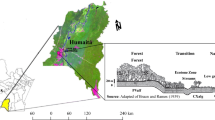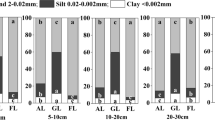Abstract
In highlands of semiarid Turkey, ecosystems have been significantly transformed through human actions, and today changes are taking place very rapidly, causing harmful consequences such as soil degradation. This paper examines two neighboring land use types in Indagi Mountain Pass, Cankiri, Turkey, to determine effects of the conversion of Blackpine (Pinus nigra Arn. subsp. pallasiana) plantation from grassland 40 years ago on soil organic carbon (SOC) and soil erodibility (USLE-K). For this purpose, a total of 302 disturbed and undisturbed soil samples were taken at irregular intervals from two sites and from two soil depths of 0–10 cm (D1) and 10–20 cm (D2). In terms of SOC, conversion did not make any statistical difference between grassland and plantation; however, there were statistically significant differences with soil depth within each land use, and SOC contents significantly decreased with the soil depth (P < 0.05) and mostly accumulated in D1. SOC values were 2.4 and 1.8% for grassland and 2.8 and 1.6% for plantation, respectively, at D1 and D2. USLE-K values also statistically differed significantly with the land use, and in contrast to the statistics of SOC, there was no change in USLE-K with the soil depth. Since USLE-K was estimated using SOC, hydraulic conductivity (HC) and soil textural composition––sand (S), silt (Si), and clay (C) contents of soils––as well as SOC did not change with the land use, we ascribed the changes of USLE-K with the land uses to the differences in the HC as strongly affected by the interactions between SOC and contents of S, Si, and C. On an average, the soil of the grassland (USLE-K = 0.161 t ha h ha−1 MJ−1 mm−1) was more erodible than those of the plantation (USLE-K = 0.126 t ha h ha−1 MJ−1 mm−1). Additionally, topographic factors, such as aspect and slope, were statistically effective on spatial distribution of the USLE-K and SOC.









Similar content being viewed by others
Abbreviations
- C:
-
Clay
- Si:
-
Silt
- S:
-
Sand
- SOC:
-
Soil organic carbon
- HC:
-
Hydraulic conductivity
- K:
-
Erodibility factor
- D1 :
-
0–10 cm
- D2 :
-
10–20 cm
References
Akman Y (1995) Türkiye Orman Vejetasyonu. Ank. Üniv. Fen Fakültesi Botanik Ana Bilim Dalı, Ankara (in Turkish), pp 143–154
Atalay I (1997) Geography of Turkey. Ege University Press, Izmir, 416 pp (in Turkish)
Aytuğ B (1970) Arkeolojik araştırmaların ışığı altında İç Anadolu Stepi. İ Ü Orman Fak Dergisi A 20(1):127–143 (in Turkish)
Bale CL, Charley JL (1994) The impact of aspect on forest floor characteristics in some eastern Australian sites. Forest Ecol Manage 67:305–317
Bale CL, Williams BJ, Charley JL, (1998) The impact of aspect on forest structure and floristics in some eastern Australian sites. Forest Ecol Manage 110:363–377
Bo S, Shenglu Z, Qiguo Z (2003) Evaluation of spatial and temporal changes of soil quality based on geostatistical analysis in the hill region of subtropical China. Geoderma 115:85–99
Burgess TM, Webster R (1986a) Optimal interpolation and isarithmic mapping of soil properties: I. The semivariogram and punctual kriging. J Soil Sci 31:315–331
Burgess TM, Webster R (1986b) Optimal interpolation and isarithmic mapping of soil properties: II. Block kriging. J Soil Sci 31:333–344
Cambardella CA, Elliott ET (1992) Paticulate soil organic matter changes across a grassland cultivation sequence. Soil Sci Soc Am J 56:777–783
Cambardella CA, Moorman TB, Novak JM, Parkin TB, Karlen DL, Turco RF, Konopka AE (1994) Field scale variability of soil properties in Central Iowa soils. Soil Sci Soc Am J 58:1501–1511
Casanova M, Messing I, Joel A (2000) Influence of aspect and slope gradient on hydraulic conductivity measured by tension infiltrometer. Hydrol Process 14:155–164
Celik I (2005) Land-use effects on organic matter and physical properties of soil in a southern Mediterranean highland of Turkey. Soil Tillage Res 83:270–277
Cerda A (1996) Soil aggregate stability in three Mediterranean environments. Soil Technol 9:133–140
Charles T, Garten J (2002) Soil carbon storage beneath recently established tree plantations in Tennessee and South Carolina, USA. Biomass Bioenergy 23:93–102
Dahlgren AR, Bottinger LT, Huntington LG, Amundson AR (1997) Soil development along an elevation transect in the western Sierra Nevada, California. Geoderma 78:207–236
Davis MR, Lang MH (1991) Increased nutrient availability in topsoils under conifers in the south Island high country. N Z J For Sci 21:165–179
Eshetu Z, Giesler R, Högberg P (2004) Historical land use affects the chemistry of forest soils in the Ethiopian highlands. Geoderma 118:149–165
Evrendilek F, Celik I, Kilic S (2004) Changes in soil organic carbon and other physical soil properties along adjacent Mediterranean forest, grassland, and cropland ecosystems in Turkey. J Arid Environ 59:743–752
Ganuza A, Almendros G (2003) Organic carbon storage in soils of the Basque Country (Spain): the effect of climate, vegetation type and edaphic variables. Biol Fertil Soils 37:154–162
Garten CT, Ashwood TL (2002) Landscape level differences in soil carbon and nitrogen: implications for soil carbon sequestration. Global Biogeochem Cycles. 16(4):61:1–61:14
Gee GW, Bauder JW (1986) Particle-size analysis. In: Klute A (ed) Methods of soil analysis, part 1, 2nd edn. Agron. Monogr. 9. ASA/SSSA, Madison, pp 383–411
Gessler PE, Chadwick OA, Chamran F, Althouse L, Holmes K (2000) Modeling soil–landscape and ecosystem properties using terrain attributes. Soil Sci Soc Am J 64(6):2046–2056
Güner ŞT (2001). Afyon Orman İşletme Müdürlüğü, anadolu karaçamı (Pinus nigra Arn. subsp. Pallasiana––Lamb. Holmboe) meşçerelerindeki doğal gençleştirme çalışmalarının değerlendirilmesi. Süleyman Demirel Üniversitesi Orman Fakültesi Dergisi, 2, pp 61–74 (in Turkish)
Hartman RE, Lloyd WJ (1969) The influence of aspect on forests of the Clarksville soils in Dent Country, Missouri. J For 67:178–182
Hicks RR, Frank PS (1984) Relationship of aspect to soil nutrients, species importance and biomass in a forested watershed in west Virginia. Forest Ecol Manage 8:281–291
Hutchins RL, Hill JD, White EH (1976) The influence of soil and microclimate on vegetation of forested slopes in eastern Kentucky. Soil Sci 121:234–241
Jenny H (1941) The factors of soil formation. McGraw-Hill, New York
Journal AG, Huijbregts CS (1978) Mining geostatistics. Akademic Press, New York, p 600
Kelly EF, Chadwick OA, Helinski TE (1998) The effect of plants on mineral weathering. Biogeochemistry 42(1/2):21–53
Klute A, Dirksen C (1986) Hydraulic conductivity and diffusivity: In: Klute A (ed) Methods of soil analysis, part 1. Physical and mineralogical methods, 2nd edn. Agron. Monogr. 9. ASA–SSA, Madison, pp 687–734
Lemenih M, Itanna F (2004) Soil carbon stock and turnovers in various vegetation types and arable lands along an elevation gradient in southern Ethiopia. Geoderma 123:177–188
Matheron G (1965) Principles of geostatistics. Econ Geol 58:1246–1266
Moody PW (1994) Chemical fertility of Krasnozems: a review. Aust J Soil Res 32:1015–1041
Moore ID, Gessler PE, Nielsen GA, Peterson GA (1993) Soil attribute prediction using terrain analysis. Soil Sci Soc Am J 57:443–452
Nelson DW, Sommers LE (1982) Total carbon, organic carbon, and organic matter. In: Page AL (eds) Methods of soil analysis, part 2, 2nd edn. Agron. Monogr. 9. ASA/SSSA, Madison, pp 539–579
Renard KG, Foster GR, Weesies GA, McCool DK, Yoder DC (1997) Predicting soil erosion by water: a guide to conservation planning with the revised universal soil loss equation (RUSLE). Agriculture handbook no. 703. USDA, 4004 pp
Rezaei SA, Gilkes RJ (2005) The effects of landscape attributes and plant community on soil chemical properties in rangelands. Geoderma 125:167–176
Rhoades CC, Eckert GE, Coleman DC (2000) Soil carbon differences among forest, agriculture and secondary vegetation in lower montane Ecuador. Ecol Appl 10:497–505
Richter DD, Markewitz D, Wells CG, Allen HL, April R, Heine PR, Urrego B (1994) Soil chemical change during three decades in an old-field lobloly pine (Pinus taeda L.) ecosystem. Ecology 75(5):1463–1473
Smith RL, Smith TM (2000) Elements of ecology, 4th edn. Addision Wesley Longman, INC, San Francisco
Soil Survey Staff (1951) Soil survey manual. Agriculture handbook no. 18. Agricultural Research Administration, US Department of Agriculture, Washington DC
Soil Survey Staff (1999) Soil taxonomy. A basic system of soil classification for making and interpreting soil surveys. Handbook no. 436. USDA, Washington DC
Tiessen H, Cuevas E, Chacon p (1994) The role of soil organic matter in sustaining soil fertility. Nature 371:783–785
Trangmar BB, Yost RS, Uehara G (1985) Application of geostatistics to spatial studies of soil properties. Adv Agron 38:45–94
Tsui CC, Chen ZS, Hsieh CF (2004) Relationships between soil properties and slope positioning in a low land rain forest of southern Taiwan. Geoderma 123:131–142
Turner J, Lambert M (2000) Change in organic carbon in forest plantation soils in eastern Australia. Forest Ecol Manage 133:231–247
Uehara G, Gillman G (1981) The mineralogy, chemistry, and physics of tropical soils with variable charge Cs. Westview Press, Colorado, pp 170
Wischmeier WH, Smith DD (1978) Predicting of rain fall erosion losses: a guide to conservation planning. Agriculture handbook 537. US Department of Agriculture, Washington DC, 58 pp
Wischmeier WH, Johnson CB, Cross BV (1971) A soil erodibility nomograph for farmland and construction sites. J Soil Water Conserv 26:189–193
Wu R, Tiessen H (2002) Effect of land use on soil degradation in Alpine grassland soil, China. Soil Sci Soc Am J 66:1648–1655
Yimer F, Ledin S, Abdelkadir A (2006) Soil organic carbon and total nitrogen stocks as affected by topographic aspect and vegetation in the Bale Mountains, Ethiopia. Geoderma 135:335–344
Yonker CM, Schimel DS, Paroussis E, Heil RD (1988) Patterns of organic carbon accumulation in a semiarid shortgrass steppe, Colorado. Soil Sci Soc Am J 52:478–483
Yooa KT, Amundsona R, Heimsathb AM, Dietrichc WE (2006) Spatial patterns of soil organic carbon on hillslopes: integrating geomorphic processes and the biological C cycle. Geoderma 130:47–65
Young F, Hammer R (2000) Soil–landscape relationships on a loess-mantled upland landscape in Missouri. Soil Sci Soc Am J 64(4):1443–1454
Author information
Authors and Affiliations
Corresponding author
Rights and permissions
About this article
Cite this article
Bayramin, I., Basaran, M., Erpul, G. et al. Comparison of soil organic carbon content, hydraulic conductivity, and particle size fractions between a grassland and a nearby black pine plantation of 40 years in two surface depths. Environ Geol 56, 1563–1575 (2009). https://doi.org/10.1007/s00254-008-1254-8
Received:
Accepted:
Published:
Issue Date:
DOI: https://doi.org/10.1007/s00254-008-1254-8




